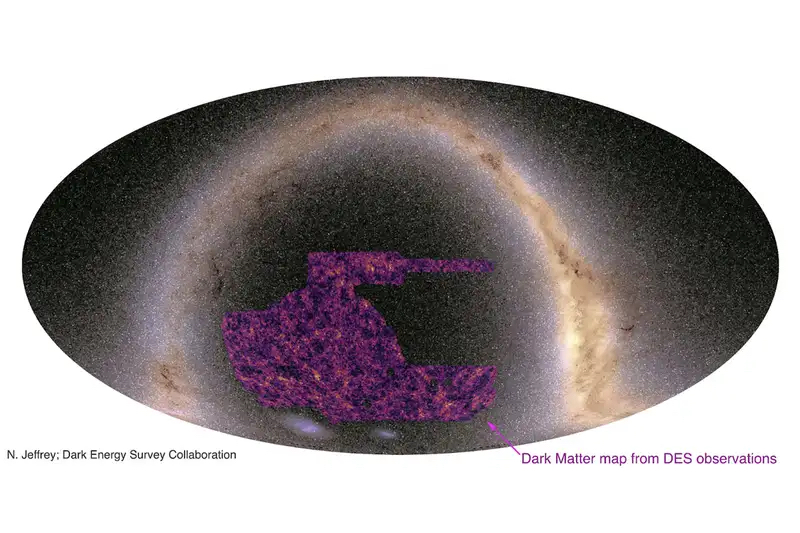
New dark matter map
Dark matter is a mysterious invisible substance that makes up most of the matter in our universe. We can’t see it, but scientists have been able to infer dark matter’s presence and to study it. Now, scientists have produced the most detailed ever dark matter map, showing the distribution of dark matter, as seen from about a quarter of the night sky visible from Earth’s Southern Hemisphere. The scientists are part of the Dark Energy Survey, a collaboration of more than 400 scientists from 25 institutions in seven countries. They used artificial intelligence, or AI, to analyze images of 226 million galaxies in the southern sky.
The map depicts all the dark matter detected in the foreground of those galaxies.
The new map helps to confirm some predictions of what astronomers call the Standard Cosmological Model, the simplest model so far that explains what’s observed in our universe. But not all the results were anticipated. Surprisingly, there were hints that the universe is smoother than expected.
These scientists announced the new map via Fermilab on May 27, 2021. The scientific results were published May 27 in the peer-reviewed Monthly Notices of the Royal Astronomical Society. There are now 26 published papers from the Dark Energy Survey, of an anticipated 30 interconnected papers to come by the project’s end.
What is dark matter?
The existence of dark matter sounds mysterious and weird … and so it is. Basically, dark matter is matter that we can’t see visually. It doesn’t emit, reflect or absorb light or any other type of electromagnetic radiation such as X-rays or radio waves. Astronomers know it’s there because they see its effects on its surroundings. For example, they “see” dark matter in galaxies that stay clustered together or galaxies within clusters that move faster than expected. In both of those examples, dark matter’s gravitational effects can be measured, though the dark matter itself can’t be seen.
Fermilab explained:
Ordinary matter makes up only about 5% of the universe. Dark energy, which cosmologists hypothesize drives the accelerating expansion of the universe by counteracting the force of gravity, accounts for about 70%. The last 25% is dark matter, whose gravitational influence binds galaxies together.
How did these astronomers study dark matter?
The scientists’ analysis of photographs of the southern sky showed the location and distribution of galaxies in that part of the sky. Since dark matter and galaxies go hand-in-hand, the arrangement of the galaxies shows astronomers where the largest concentrations of dark matter are located.
Also, just like regular matter, dark matter can curve space-time. In the Dark Energy Survey, scientists found dark matter by looking at the light coming from distant galaxies. Often, that light was seen to be distorted or bent more than what the foreground matter could account for. That meant there must be invisible matter bending the light’s path as it traveled toward us. Voila. Dark matter.
The Dark Energy Survey photographed the night sky using the 570-megapixel Dark Energy Camera on the Victor M. Blanco 4-meter Telescope at the Cerro Tololo Inter-American Observatory in Chile. Designed specifically for the Dark Energy Survey, this camera is one of the most powerful digital cameras in the world, these astronomers said.
Over the course of six years, the Dark Energy Survey surveyed 5,000 square degrees of sky, almost 1/8 of the entire sky, across 758 nights of observation. They cataloged hundreds of millions of objects. The results announced May 27 drew on data from the project’s first three years – 226 million galaxies observed over 345 nights – which the team said let them create:
… the largest and most precise maps yet of the distribution of galaxies in the universe at relatively recent epochs.

A web-like structure
Dark Energy Survey lead author Niall Jeffrey at University College London said the new map shows the “web-like” structure of our universe, revealed in many past studies. He said:
Most of the matter in the universe is dark matter. It is a real wonder to get a glimpse of these vast, hidden structures across a large portion of the night sky.
In our map, which mainly shows dark matter, we see a similar pattern as we do with visible matter only, a web-like structure with dense clumps of matter separated by large empty voids. Observing these cosmic-scale structures can help us to answer fundamental questions about the universe.
The 7-minute video below explains more about the Dark Energy Survey and its findings:
Tackling big questions
There were hints in the new work that our universe is a few percent smoother than previously thought. That’s a surprising result. It’s not aligned with the predictions of Einstein’s general relativity, which suggests that dark matter should be more clumpy and less uniformly distributed. In one of the 30 papers being released, the authors wrote that:
… Though the evidence is by no means definitive, we are perhaps beginning to see hints of new physics.
Niall Jeffrey told Technology Review:
… This would correspond to possibly changing the laws of gravity as described by Einstein.
And that would be something! All in all, the Dark Energy Survey says about itself that it:
… tackles big questions about our universe: What is it made of? How is matter distributed? How has the universe evolved? And what roles do dark matter and dark energy play?
The Dark Energy Survey is addressing these puzzles by photographing galaxies close to home and billions of light years away.

Bottom line: Astronomers with the Dark Energy Survey used artificial intelligence to create the largest-ever dark matter map.
Source: Dark Energy Survey Year 3 results – Curved-sky weak lensing mass map reconstruction











